

✨ What is Tranexamic Acid?
Tranexamic Acid (TXA) is a synthetic derivative of the amino acid lysine, originally developed as an oral medication to control bleeding (antifibrinolytic). But in recent years, it’s become a dermatologist-approved secret weapon against hyperpigmentation, melasma, and post-inflammatory discoloration.
In skincare, TXA works topically to 1)Interrupt melanin synthesis, 2)Reduce UV-induced pigmentation, 3)Soothe skin prone to redness and flare-ups.
It’s gentle, effective, and suitable even for sensitive skin — making it one of the most exciting pigment-correcting ingredients on the market today.
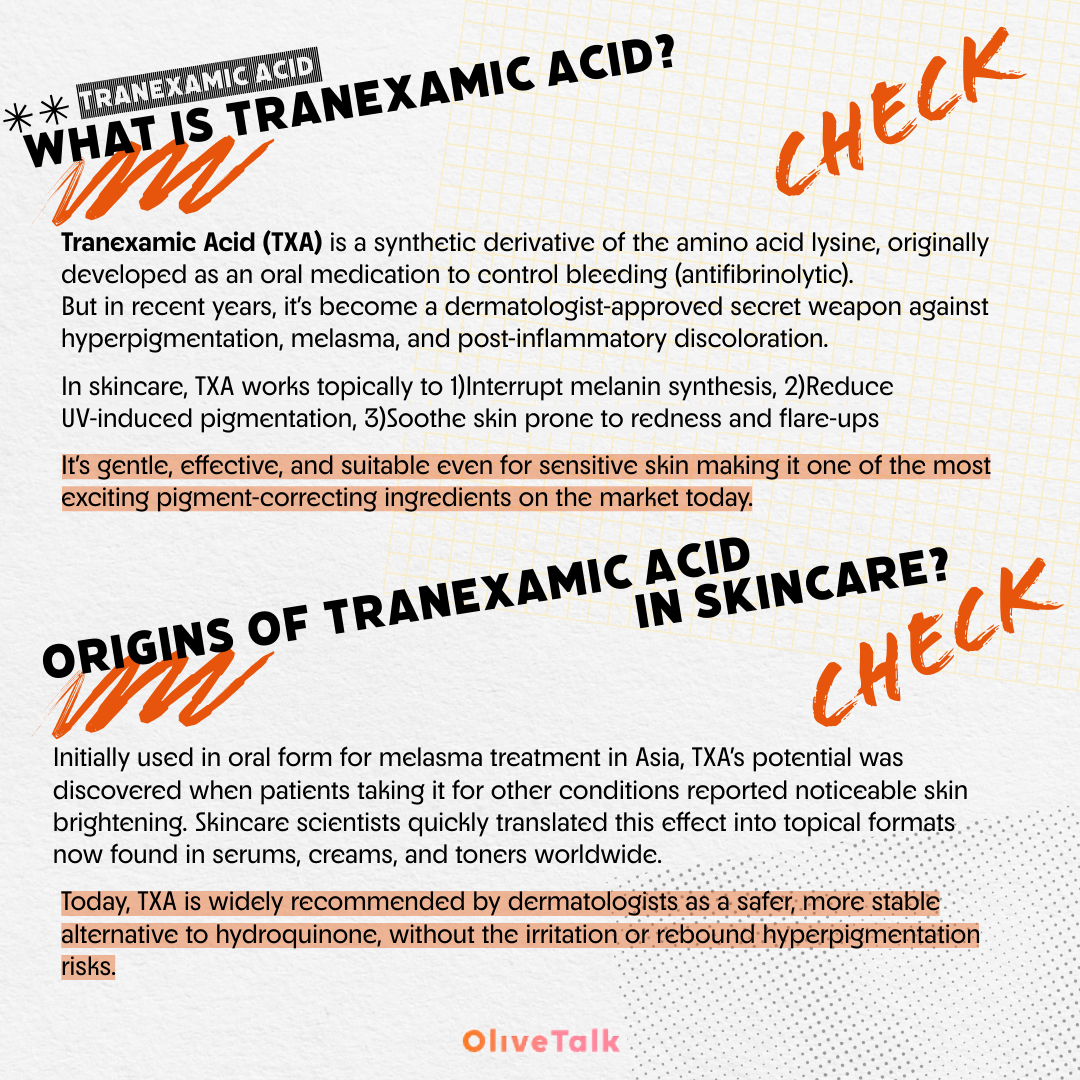
🌱 Origins of Tranexamic Acid in Skincare
Initially used in oral form for melasma treatment in Asia, TXA’s potential was discovered when patients taking it for other conditions reported noticeable skin brightening. Skincare scientists quickly translated this effect into topical formats now found in serums, creams, and toners worldwide.
Today, TXA is widely recommended by dermatologists as a safer, more stable alternative to hydroquinone, without the irritation or rebound hyperpigmentation risks.
🔍 TXA vs. Hydroquinone vs. Vitamin C
(Property / Tranexamic Acid / Hydroquinone / Vitamin C )
- Melanin Inhibition / Moderate / Strong / Mild to Moderate
- Irritation Risk / Very low / High (especially long-term) / Low to moderate
- Safety for Daily Use / Excellent / Not ideal / Generally good
- Pregnancy Safe / Yes (topical) / No / Cautiously, yes
※ Tranexamic Acid offers a safer long-term solution to persistent pigmentation with far fewer side effects.
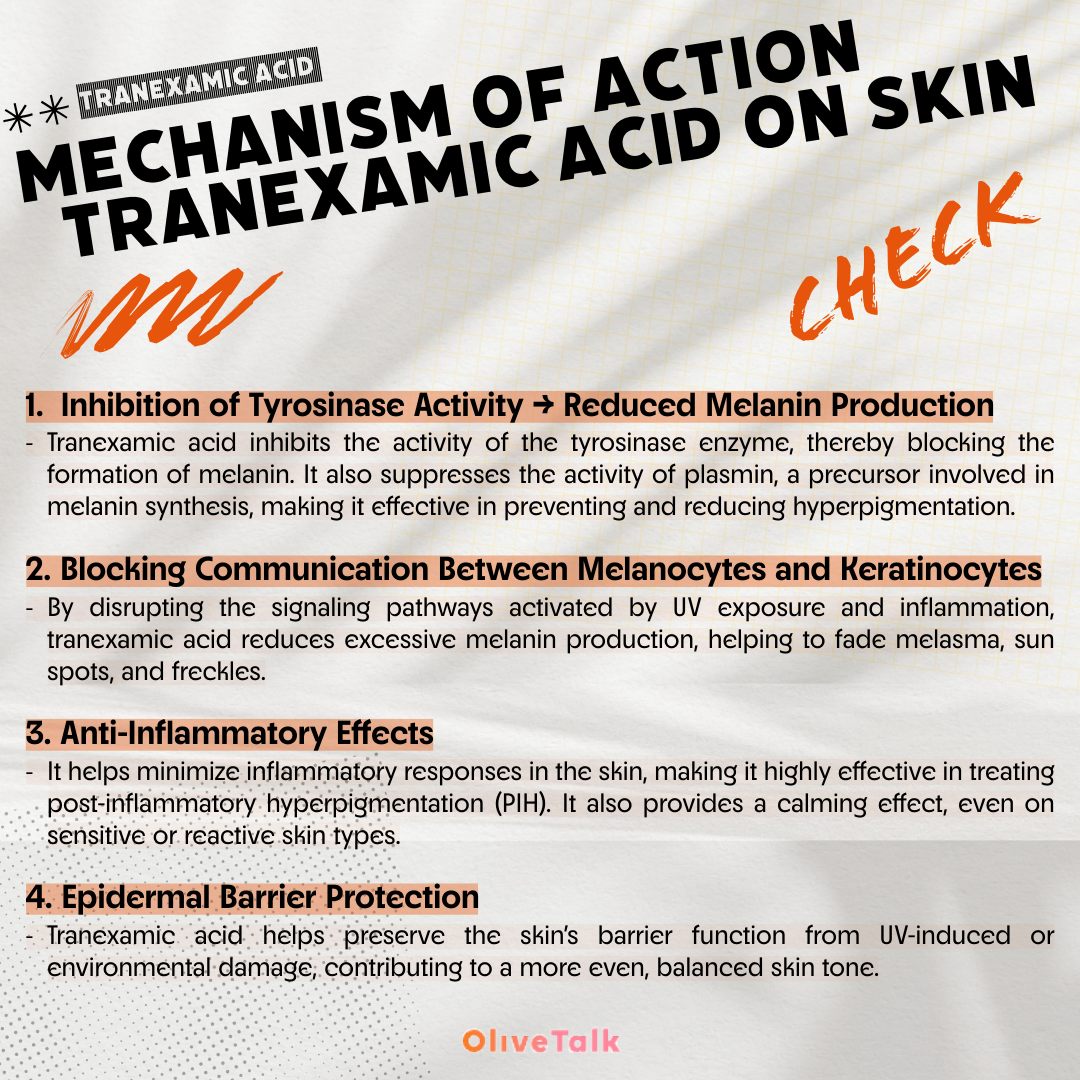
🔬 Mechanism of Action I (Brightening at the Root)
TXA blocks plasminogen activation in the skin, which in turn 1)Inhibits melanocyte activation (the pigment-producing cells), 2)Calms inflammatory triggers (especially post-acne or rosacea-related), 3)Disrupts the communication between UV exposure and pigment production
※ This makes it particularly helpful for melasma, PIH (post-inflammatory hyperpigmentation), and sunspots.
💡 Mechanism of Action II (Full-Spectrum Benefits)
1) Fades dark spots without bleaching surrounding skin
2) Works well with niacinamide, kojic acid, and azelaic acid
3) Soothes redness-prone or post-acne reactive skin
4) Doesn’t increase skin sensitivity to sunlight (unlike some actives)
5) Can be layered easily in most routines without conflict
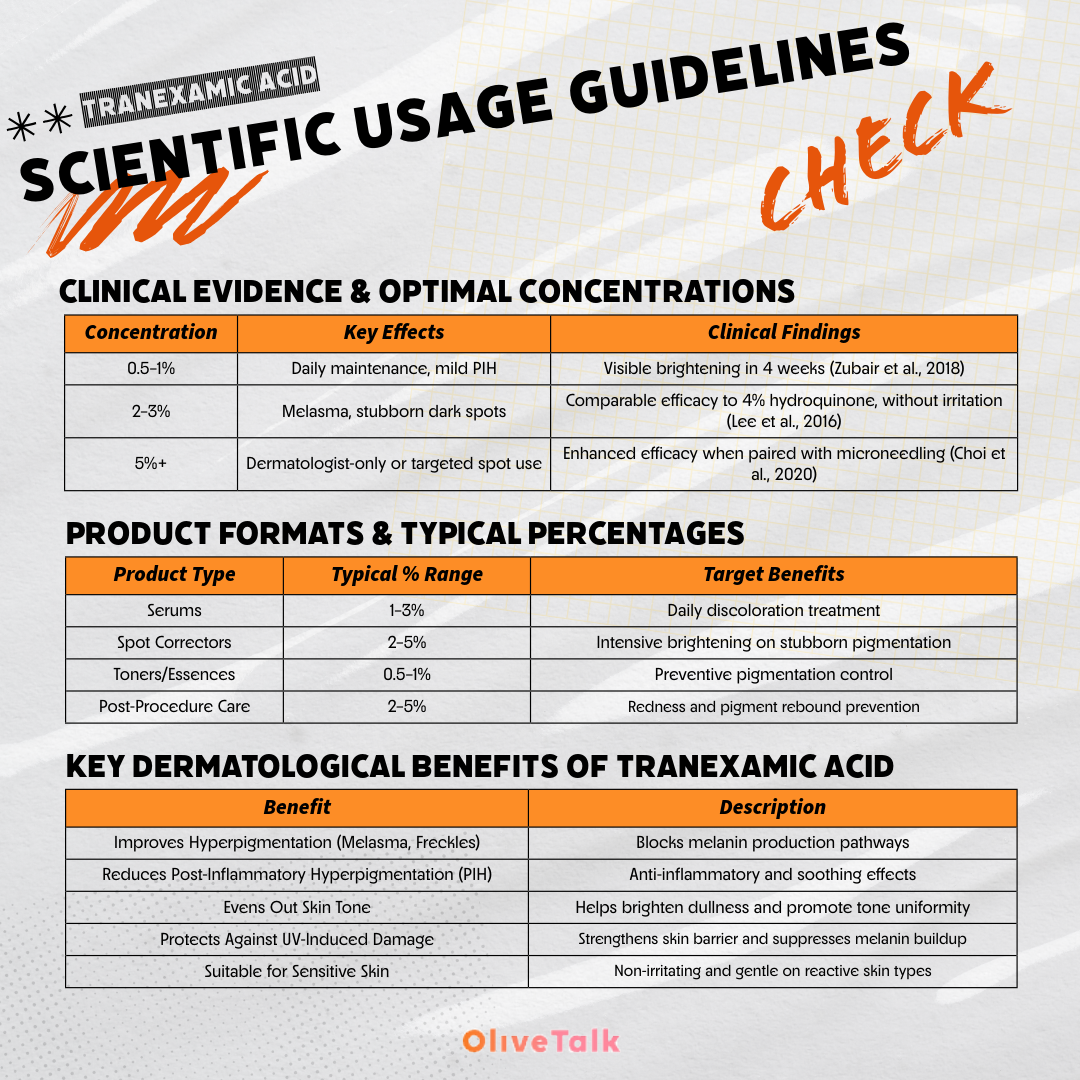
🧪 Clinical Evidence & Optimal Concentrations
(Concentration / Key Effects / Clinical Findings)
- 0.5–1% / Daily maintenance, mild PIH / Visible brightening in 4 weeks (Zubair et al., 2018)
- 2–3% / Melasma, stubborn dark spots / Comparable efficacy to 4% hydroquinone, without irritation (Lee et al., 2016)
- 5%+ / Dermatologist-only or targeted spot use / Enhanced efficacy when paired with microneedling (Choi et al., 2020)
🧴 Product Formats & Typical Percentages
(Product Type / Typical % Range / Target Benefits)
- Serums / 1–3% / Daily discoloration treatment
- Spot Correctors / 2–5% / Intensive brightening on stubborn pigmentation
- Toners/Essences / 0.5–1% / Preventive pigmentation control
- Post-Procedure Care / 2–5% / Redness and pigment rebound prevention
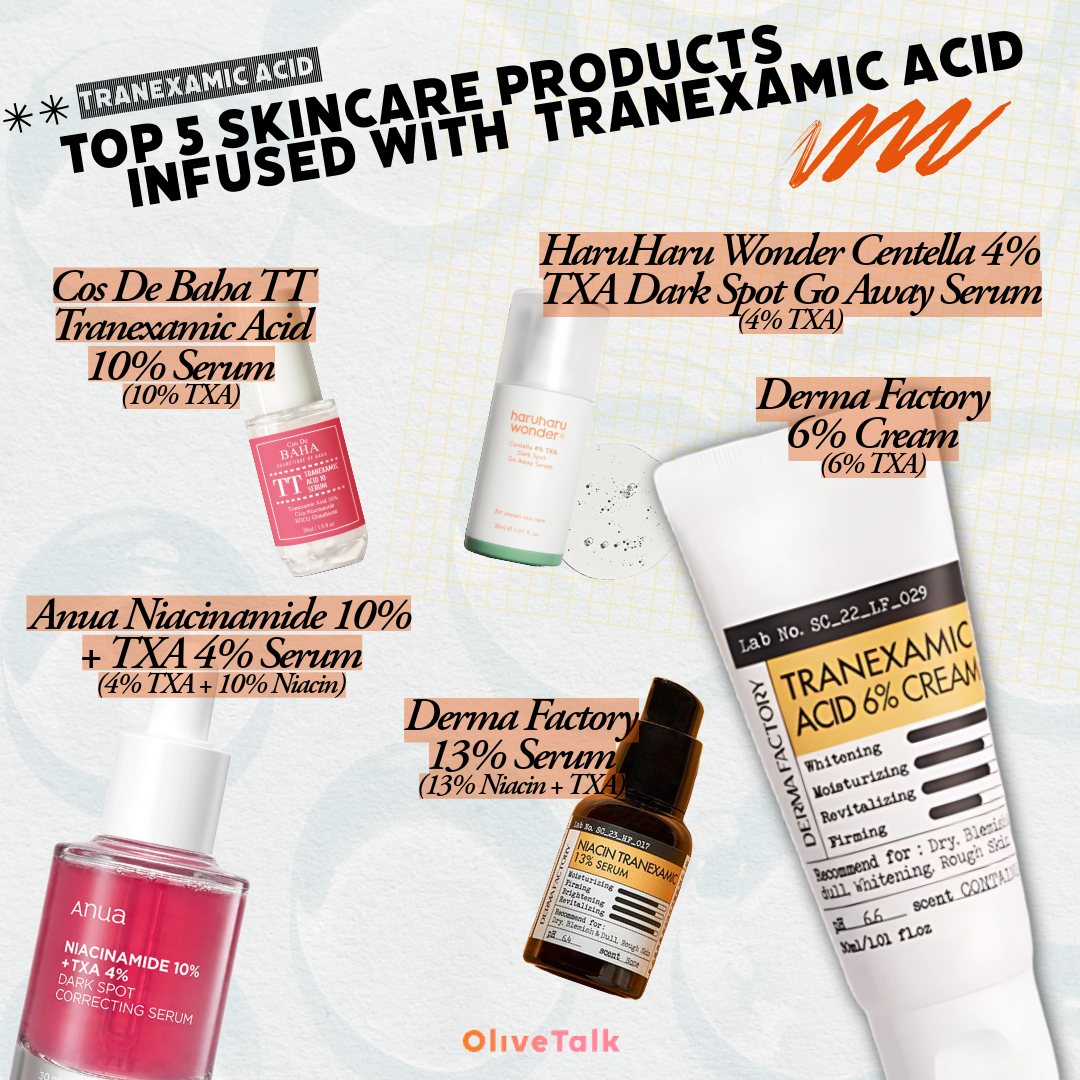
<Top 5 Skincare Products Infused with Tranexamic Acid>
1. Derma Factory Tranexamic Acid 6% Cream
Concentration : 6% TXA
Country : South Korea
2. Derma Factory Niacin Tranexamic 13% Serum
Concentration : 13% (Niacin + TXA)
Country : South Korea
3. Anua Niacinamide 10% + TXA 4% Serum
Concentration : 4% TXA + 10% Niacin
Country : South Korea
4. HaruHaru Wonder Centella 4% TXA Dark Spot Go Away Serum
Concentration : 4% TXA
Country : South Korea
5. Cos De Baha TT Tranexamic Acid 10% Serum
Concentration : 10% TXA
Country : South Korea
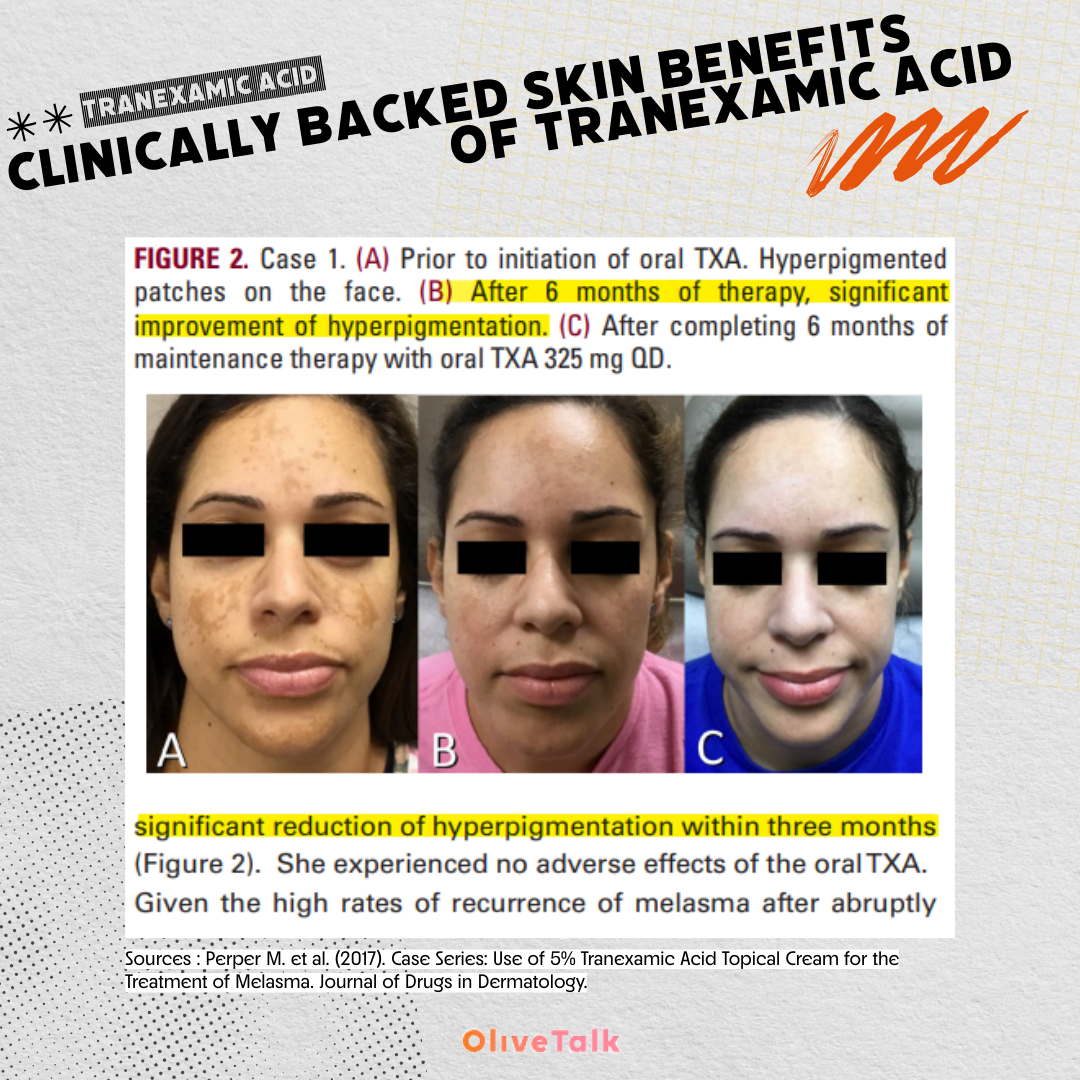
🏛️ Historical Note: From Hospital to Vanity Shelf
Once a prescription-only hemostatic agent, TXA’s journey into skincare is a case study in medical repurposing. What started in surgical wards is now a skincare essential — combining medical credibility with daily cosmetic appeal.
💾 Final Thoughts from a Skincare Expert
If you're dealing with melasma, sun spots, or stubborn post-acne marks, tranexamic acid is one of the smartest additions to your routine. It’s non-bleaching, low-irritation, and science-backed — the kind of ingredient derms love and sensitive-skin users trust.
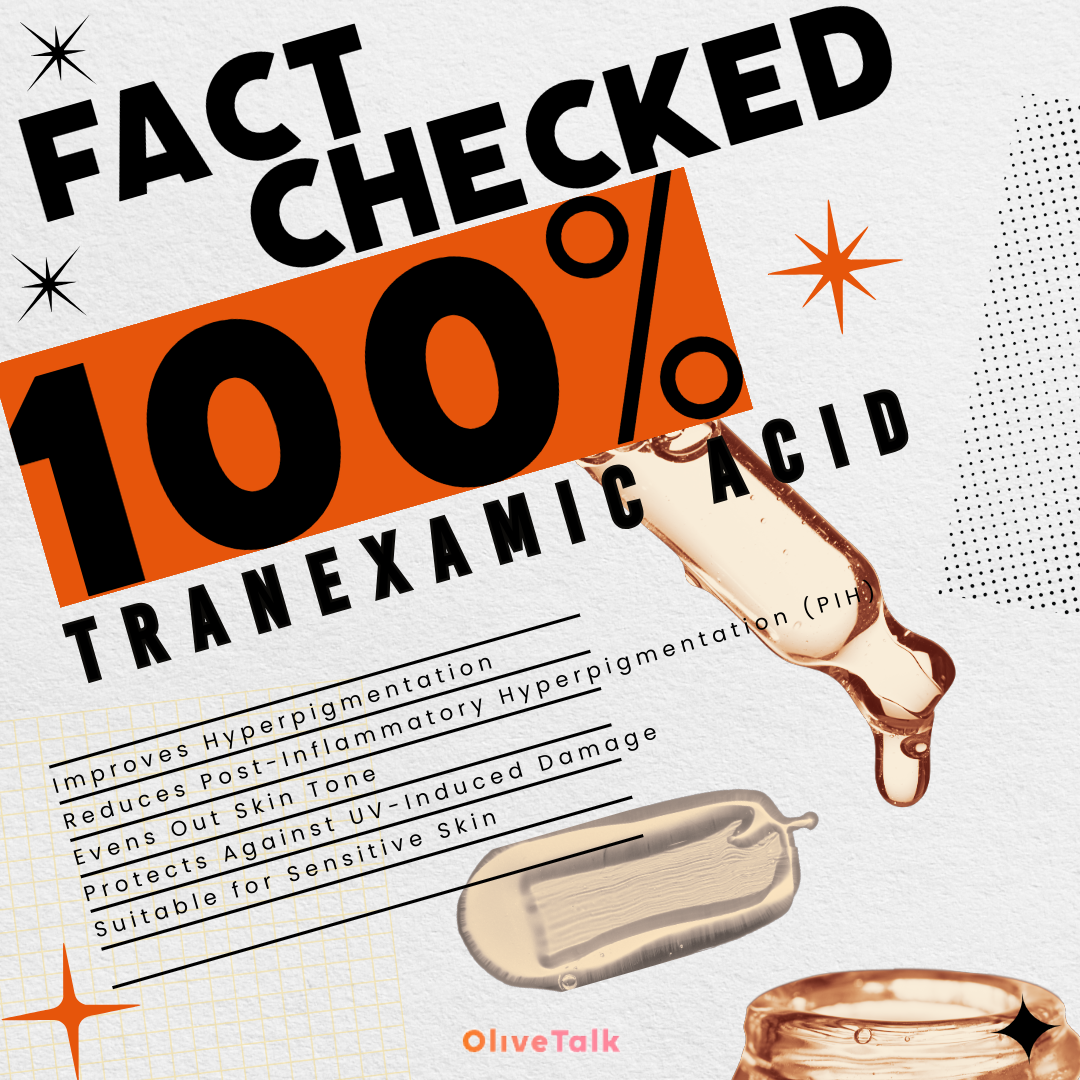
📚 References
1. Zubair, R. et al. (2018)
Topical tranexamic acid showed significant melasma improvement with fewer side effects compared to hydroquinone in a double-blind study.
International Journal of Dermatology, 57(6), 715–720.
2. Lee, H. S. et al. (2016)
2% TXA cream demonstrated comparable efficacy to 4% hydroquinone with better skin tolerability.
Journal of Cosmetic and Laser Therapy, 18(3), 167–171.
3. Choi, H. et al. (2020)
Microneedling enhanced tranexamic acid absorption and improved pigmentation in melasma patients.
Dermatologic Surgery, 46(4), 500–506.
4. Rodrigues, M. et al. (2019)
Expert consensus supports TXA as a first-line adjuvant for melasma, based on multiple clinical outcomes.
Pigment Cell & Melanoma Research, 32(5), 682–690.
5. Kanechorn Na Ayuthaya P. et al. (2012)
Topical 5% TXA gel reduced melanin index by 78.2% in 12 weeks in Asian skin types.
Journal of Cosmetic and Laser Therapy, 14(3), 150–154.
6. Lee JH. et al. (2006)
Localized intradermal microinjection of TXA significantly decreased MASI scores over 12 weeks.
Dermatologic Surgery, 32(5), 626–631.
7. Maeda K. & Naganuma M. (1998)
TXA inhibits UV-induced melanogenesis by suppressing plasmin activity and tyrosinase expression.
International Journal of Cosmetic Science, 20(4), 291–303.
8. Taraz M. et al. (2017)
Comprehensive review confirms TXA’s efficacy in various delivery forms (topical, oral, injectable) for hyperpigmentation.
Dermatologic Therapy, 30(3), e12465.
9. Janney MS. et al. (2019)
5% TXA cream had similar brightening effect as 3% hydroquinone, but with improved patient comfort.
Journal of Cutaneous and Aesthetic Surgery, 12, 63–67.
 29Comments
29Comments
Wondering if I just need to bump up to 5% or pair it with microneedling?
Open to suggestions, trying to avoid laser right now!!
Btw do you use it daily or just a few times a week?